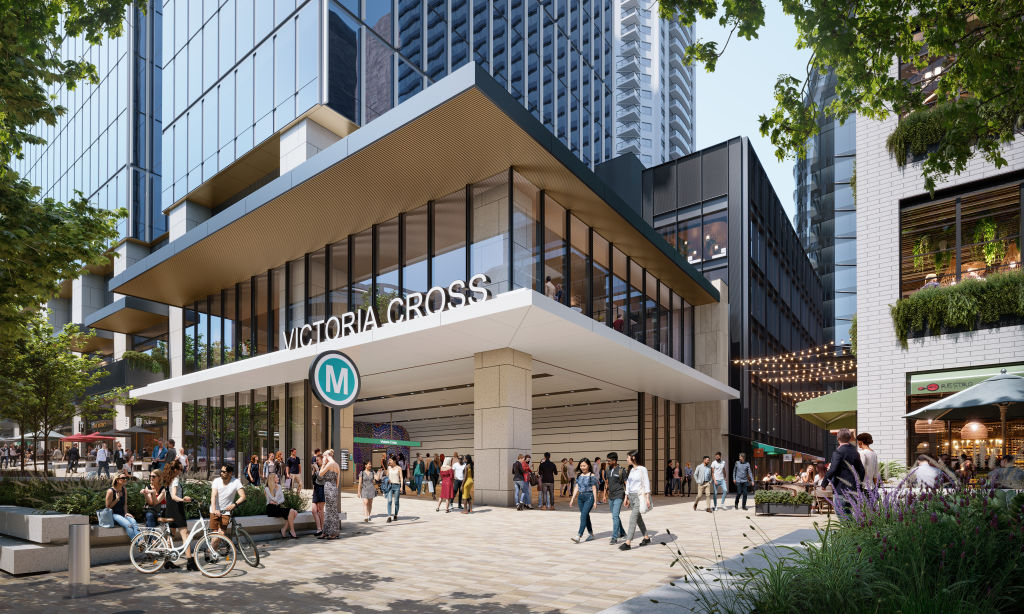New train, metro and light rail projects around the country are also going to be home to new shopping centres, office towers, industrial hubs and, yes, apartment blocks.
As space in inner and middle suburbs becomes more scarce, developers are looking to the land around and the air rights above train stations and public transport hubs.
Savills Victoria CBD and metropolitan sales director Clinton Baxter said it was an alternative to developing greenfields sites on the urban fringe.
“Land around and air rights above train stations and public transport hubs can be very valuable – especially appealing to apartment developers and retail businesses – given the congregation and ease of movement of people and potential customers,” he said.
“Government authorities have been increasingly looking at ways to ‘monetise’ the value of land adjacent to, and air space above, train stations, train lines, and transport hubs.
“Facilities planned for commuters – often selling off the air rights for development allows the rail authority to provide a higher level of commuter amenity and/or to integrate retail offerings into the station design.”
City station developments
Victoria’s metro tunnel project will include two major new train stations in the Melbourne CBD – Town Hall and State Library.
“The Metro Tunnel Authority is planning to create major retail and commercial hubs above the station and seek to maximise the commercial potential and return from these spaces above the station,” Mr Baxter said.
He said the air rights above State Library station had been sold to Scape, a major student accommodation developer and provider, as part of a deal when a site on La Trobe Street was compulsorily acquired from Scape for the station.
“We had sold the site to Scape for $35 million just weeks before the project was announced,” Mr Baxter said.
In NSW, the Sydney Metro development will include the Victoria Cross station in North Sydney, which has commercial, retail and transport elements.
The $1.2 billion commercial tower and urban precinct is already under way as a partnership between Sydney Metro and Lendlease and designed by architects Bates Smart. To be completed by 2024, it will feature a 42-storey next-generation workplace, a shopping centre and a community hub.
With the aim of achieving a Platinum WELL and six-star green star rating, the workplace – which can accommodate up to 7000 workers – will feature a lobby with a multi-purpose hub space designed to promote community connection, outdoor balconies and green or “biophilic” spaces for health and wellbeing.
“Around the world, people are increasingly demanding workplaces that have outstanding sustainability and digital credentials, are linked to public transport, and are stitched into the local community. We know our new Victoria Cross Development will respond to these demands,” Lendlease integrated transport development and development NSW head Jeheon Son said.
On track to increase access
Across the country, works are well under way on many transport links.
In Perth’s eastern suburbs, the $1.86 billion Forrestfield Airport Link in on track for its first trains to run later this year. With new stations at Redcliffe, Airport Central and High Wycombe, the rail service has been promoted as better supporting tourists travelling between the city and the airport while also increasing residential and commercial development.
LJ Hooker Commercial Perth industrial director and licensee Colm McHugh said the link had attracted many warehouse and logistics companies to the area.
“Traditionally, it hasn’t been easy to get your hands on industrial land [for owner-occupiers], so with the airport link it means that it improves the land value and it gets your workforce in and out quicker, people will go there over other areas because of that access,” he said.
In Queensland, the Gold Coast light-rail project is progressing to stage three, which will see the tram network grow from Helensvale to Burleigh Heads.
CBRE Gold Coast managing director Mark Witheriff said the overall town planning vision was to create density outside the rail line and developers had taken the opportunity from owner-occupier investment, tourism offerings to apartments.
Land in demand
Nationally, land near transport hubs has been in demand. A vacant lot near Hornsby train station in Sydney recently sold for $1.1 million, with its proximity to public transport links part of the appeal. Sold by CI Australia on behalf of Transport for New South Wales to a private investor, the campaign saw interest from boutique developers, owner-occupiers, builders and local investors.
On top of that, the new NorthConnex tunnel has improved accessibility in and out of the area, particularly to the north shore and the CBD.
“Many were attracted to the site’s flexible B6 – Enterprise Corridor zoning, its proximity to Hornsby railway station and retail area, together with its high-profile frontage to the Pacific Highway,” CI chief executive Andrew Hunter said.
In western Sydney, industrial property is in high demand with government projects prompting businesses and industries to relocate within the path of the Sydney Metro west rail.
Heavy equipment manufacturer Manitou Australia will relocate from Rosehill to Lidcombe due to the rail project.
“The Manitou deal reflects the need for some industries to position their operations east of Parramatta and with close access to the M4 Motorway,” Colliers International industrial national director Tony Durante said.
Several large corporates and smaller private businesses that are being displaced due to government property acquisitions for the rail project are continuing to comb the market for other premises, he said.
